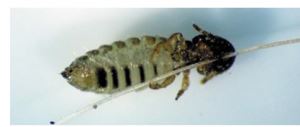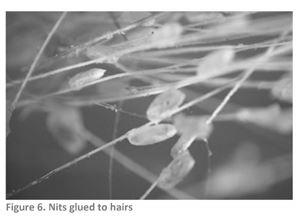|
Lice: An Additional Potential Stress On Livestock
DR. LEE TOWNSEND
LEXINGTON, KY.
The most obvious symptoms of lice include excessive rubbing and loss of hair clumps. However, there are some other possible causes (ringworm, dietary deficiencies, mange, etc.). A careful examination of animals will let you identify the problem or combination of problems correctly.
Typically, there are raw spots from constant attempts to groom or scratch areas where lice are abundant. More specifically, you should find lice and eggs (nits). Lice are small, flat-bodied insects that are uniquely adapted to live as external parasites on animals. They are generally host-specific insects that cannot survive off their host for more than a few days. Sucking lice, with their narrow, pointed heads, are blood feeders. Biting lice with wide triangular heads feed by scraping material from the dermis and base of the hairs. Females of both types glue their eggs (or nits) to hairs so the coat may have a matted appearance.

Figure 6. Biting louse with a wide, triangular head. Many species have dark stripes across their body

The energy that lice “steal,” coupled with other factors, can have a severe impact on animal health. Infestations of biting and sucking lice have been associated with reduced weight gains and general unthriftiness. In most cases, it has been difficult to attribute direct losses specifically to sucking or biting lice. However; moderate to heavy infestations of these species add to the impact of cold weather, shipping stress, inadequate nutrition, or loads imposed by internal parasites or disease. Also, a synergism between low levels of both lice and intestinal nematodes can reduce weight gains. Other manifestations can include anemia, slow recovery from diseases, poor gain performance, or general unthriftiness.
Lice, most abundant during the winter, are easily transferred by direct contact. Crowding or bunching provides many chances for lice to move throughout the herd. Reduced light intensity is thought to play a significant role in population dynamics of these insects, but nutrition, general health, reduced immune system response, and cold weather are important factors, too.
Monitoring louse numbers
Confirm lice by examining heavily rubbed areas on the animals. Most lice species have preferred feeding sites where they are most likely to be found when numbers are low to moderate. In severe infestations, they must spread more widely over the animal. Sucking lice tend to be densely packed, creating characteristic quarter-sized black or blue-brown spots. Also, they are less likely to move or to be disturbed when the hair is parted during examinations. Biting lice tend to occur in groups but not tightly packed clusters. They are active and move quickly if disturbed.
Short-term louse control
Depending on the situation, dewormers or insecticides provide quick knockdown of active infestations. Longer term practices ultimately can be incorporated into an integrated louse control program.
A single application of any one of many systemic dewormers, such as doramectin, eprinomectin, ivomectin, or moxidectin, provides long-term louse control for cattle. However, a winter application may trigger an adverse host- parasite reaction if the animals were not treated in the fall to control cattle grubs.
A variety of contact (non-systemic) insecticides with active ingredients such as cyhalothrin, cyfluthrin, or permethrin provide good control of lice. They are sold in a variety of formulations (pour-on, spot-on, or dusts) that can be applied during cold weather. Dust bags or back rubbers may be used to dispense these products, as well.
Even if insecticide coverage on the animal is not thorough, there should be sufficient to knock down heavy infestations to reduce stress on the animals. Contact insecticides do not kill nits so a follow-up treatment is needed to control lice that emerge from eggs after the residual effect of the insecticide is lost. The insecticide label will tell you how long to wait before applying the second treatment. Any animals that are not treated will rekindle the infestation.
Long-term integrated management of lice includes combinations of the following methods as practical:
Culling reservoirs or carriers: Lice persist over the summer months on a small number of chronically infested reservoir animals. The parasites are
transferred to other animals in fall and winter. It is difficult to detect reservoir animals, but they may be older, have compromised immune systems, or reduced ability to groom. General physical attributes can come into play. For example, the longer, thicker hair and massive neck and shoulders of bulls makes self-grooming, which can reduce louse numbers, difficult.
Nutrition: A high-energy ration seems to modify the effects of lice on weight gains, perhaps because lice populations decline on better-fed animals. Therefore, a sound feeding program and high energy ration serves as the foundation of a louse control program.
Premises sanitation: Live louse and nit transfer could occur from hair left on fences, truck rails, or bedding. Sucking lice usually die after just a few hours off the host, but biting lice can survive for several days under ideal conditions. A clean-up and insecticide application to facilities used by infested animals or a 10 day interval before introducing new stock will minimize the chances of carryover.
Quarantine: In enterprises where animals move in and out of the inventory on a regular basis, it is best to assume that all incoming animals are infested. They should be isolated until their full course of treatment is completed.
Repair fencing: Cross-fence contact can be sufficient for spread of these insects, especially during the winter when louse burdens are greatest.
Effective biting fly control program: Lice on reservoir animals may be suppressed during the summer by treatments applied to protect animals from biting flies and ticks.∆
DR. LEE TOWNSEND: Extension Entomologies, University of Kentucky
|
|